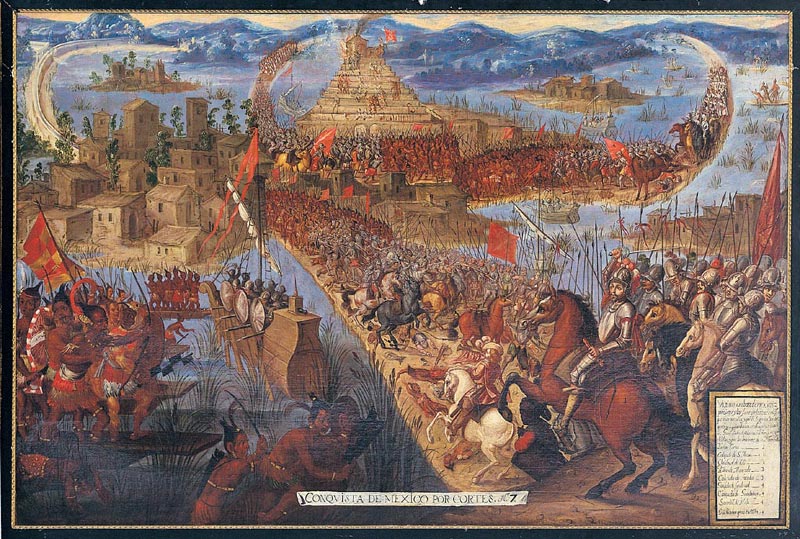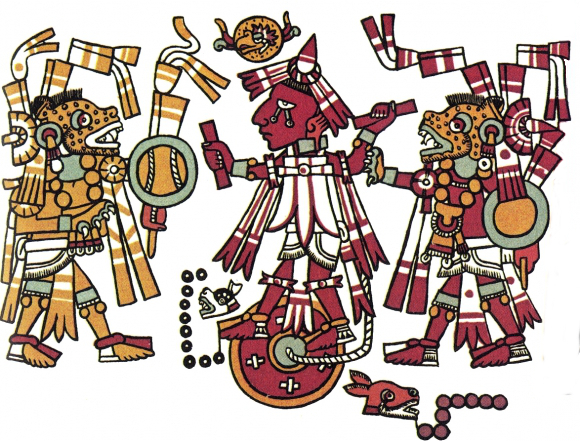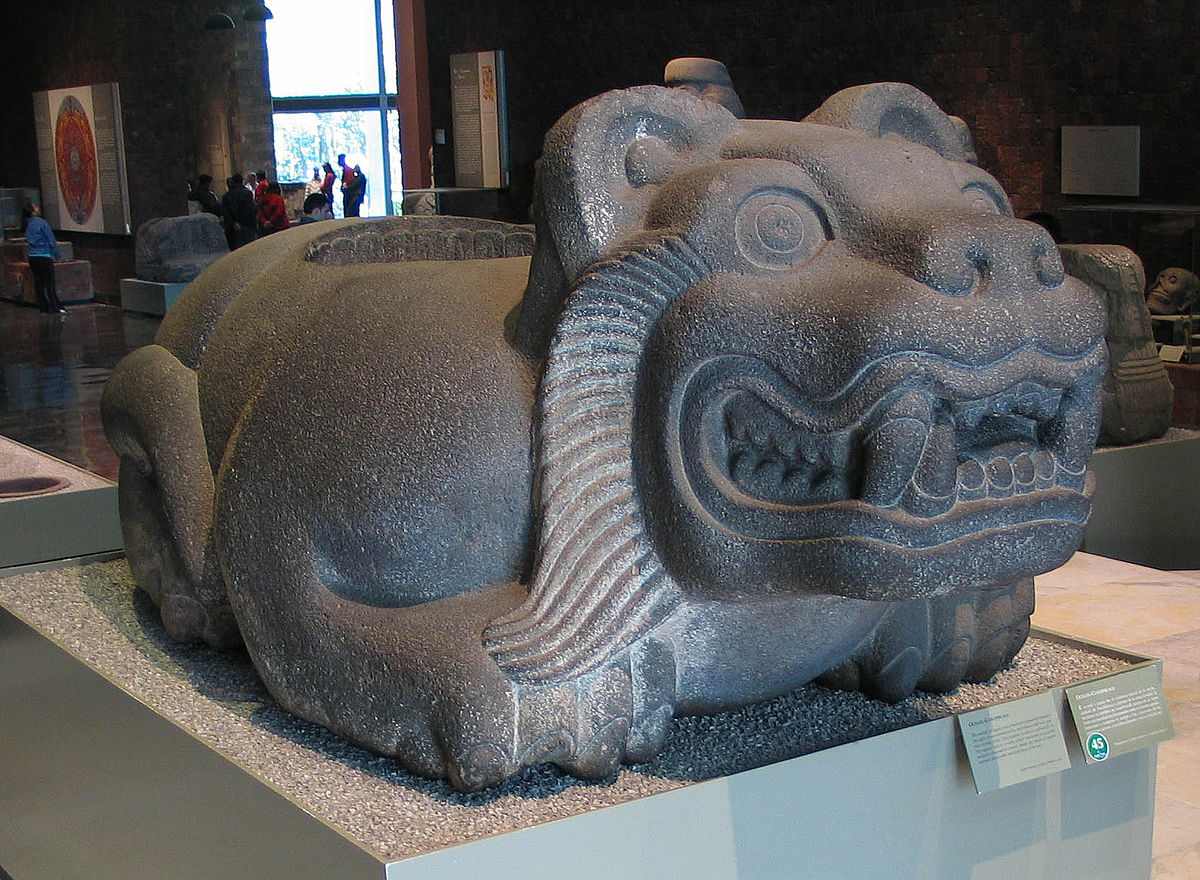
Aztec Sun Stone
The Aztec Empire constituted the greatest empire in Mesoamerican prehistory, both territorially and demographically, extending from highland basins to coastal plains, valleys and lowland forests. The Mexica – as the Aztec people are known – arrived in the Basin of Mexico around AD 1250. In 1428, the Mexica joined with two other powerful city-states in the Basin of Mexico (the Acolhua of Texcoco and the Tepaneca of Tlacopan) to form an imperial Triple Alliance. This tripartite union conquered other city-states in the Basin of Mexico and then subjugated peoples throughout present-day Mexico by expanding in all directions and as far south as the Guatemala border. The area making up the ancient city-state of Tenochtitlan lies beneath today’s sprawling Mexico City (Berdan 2017).
At the height of Aztec power (ca. AD 1500), the city-state of Tenochtitlan boasted between 200,000 and 250,000 inhabitants. Its size was unusual, as the next largest city (Texcoco) is estimated at 25,000 people, and the typical city in central Mexico contained only around 5,000 residents. (Find a comprehensive overview of Mexica culture in our eHRAF Culture Summary).

The Conquest of Tenochtitlan, from the Conquest of México series. Representing the 1521 Fall of Tenochtitlan, in the Spanish conquest of the Aztec Empire (via Library of Congress).
In addition to the size of its empire, Aztec culture was impressive in a number of ways. For at least two millennia prior to Spanish conquest in 1519, “Mexico supported a flourishing civilization that produced institutions of an exceedingly high order. During this long period of alternating creative activity and stagnation typical of maturing civilizations, a cultural evolution took place which saw the development of ceramics, sculpture, architecture, mural painting, writing and chronology, complex religious doctrines, systems of education, and diverse political, religious, and social organizations” (León Portilla 1963: vii).
The ancient Aztecs – whose modern-day descendants are known as Nahua or Nahuatl speakers – had elaborate art, architecture, codices, laws, religion and a scientific expression of time for which we have evidence of today in the form of stone artifacts. Some of the most recognizable monoliths of Aztec or Nahua culture include the ancient Mexica Sun Stone. Currently housed in the National Museum of Mexico City, the 12-foot-wide, carved stone disc is believed to date back to at least the early 1500s. The carvings throughout the sculpture depict various aspects of Mexica cosmology.
The video below decodes the Aztec symbolism and science behind the famous Sun Stone, which we now know was once painted with vibrant colors.
Some debate remains regarding the original purpose and origin of the stone, but most anthropologists and archaeologists suggest that it primarily had a calendrical function:
The astronomy of the Aztecs and Mayas, although closely tied to religious ideas, represents beyond any doubt a rational effort to understand the universe. The astronomical concepts reveal a rational aspect in the points which served as frames of reference for chronology. Pre-Columbian astronomy is, then, necessarily bound to arithmetic in forming the Calendar, and the latter demonstrates how these peoples conceived time in the universe (León Portilla 1963: 219; see also Caso 1971).
However, more recent discoveries and interpretations by archaeologists suggest that it may also have had ritualistic purposes at the center stage of a significant public performance, albeit one that would be rather shocking to contemporary observers. Aztec tradition included the belief that human blood must be sacrificed at regular intervals in the calendrical cycle. Stone artifacts and monoliths were utilized in these rituals. Brundage (1972: 105-106) illustrates one such scene (found in eHRAF World Cultures):
Here they sacrificed to the sun those whom they had captured in battle. […]The cult was centered about the two stone wheels, the temalacatl and the cuauhxicalli, “the sun vessel.” The temalacatl was a heavy stone wheel lying horizontally on a low square platform to which access was gained on each side by a low flight of four steps. The victim to be sacrificed was provided with a wooden sword-club, edged not with sharp obsidian blades as was customary, but with feathers or puffs of cotton. He was tied by a short cord to the center of the stone and forced to defend himself against four knights, two jaguar and two eagle knights, each armed with their usual weapons. In the ensuing duel the victim, no matter how well he defended himself, was finally wounded, whereupon he was untied and dragged still living up the temple steps to be thrown onto the cuauhxicalli …. Here he was decapitated, his blood flowing across the surface of the stone in a groove and spilling over the edge. His heart was ripped out and offered to the sun while the trophy head was held aloft in a frenzied dance around the temalacatl. The corpse was then skinned, and a young priest ceremonially wore it for many days until it cracked and otherwise became too offensive.
- Representation of gladiatorial combat on a temalacatl. Codex Zouche-Nuttall.
- Jaguar shaped Cuauhxicalli in the National Museum of Anthropology of Mexico
Ready to learn more?
HRAF’s collections on Aztec culture are some of the most extensive in our eHRAF Databases. There are two culture files in eHRAF World Cultures: Aztecs (NU07), covering the period from 1200 to 1500, and Nahua (NU46) for modern Nahuatl speakers of Mexico. eHRAF Archaeology likewise contains the Aztec Empire in the Central Mexico Postclassic (NU93) tradition and Aztec ruins under Early Anasazi (NT95). In eHRAF World Cultures, the collections total 6,802 pages across 33 documents. In the two collections in eHRAF Archaeology, there are 7,772 across 143 documents.
Throughout the collections you will find various ethnonyms: the Aztecs (generally referring to the Nahuatl-speaking peoples of the Basin of Mexico), Mexica, Tenochca (referring specifically to the Aztec people of the city-state of Tenochtitlan), Culhua-Mexica (Tenochtitlan peoples, but emphasizing their political links to the prestigious Culhua). For the modern Nahuatl-speakers, this includes Mexicano, Mexicanero, Tepoztecan, Huasteca Nahua, Nahuatl, and Aztec. The Nahua are Native Americans who trace their ethnic origin and identity to the Nahuatl-speaking Aztecs. More commonly, the Nahua refer to themselves as “Mexicano” derived from the ancient Nahuatl word “Mexica.” The majority live in Mexico, but pockets of Nahua communities are also found in Guatemala, El Salvador, Honduras and Nicaragua.
FRAN BARONE / 17 Nov 2017
References
Berdan, Frances F. 2017. “Culture Summary: Aztecs.” New Haven, Conn.: Human Relations Area Files. http://ehrafworldcultures.yale.edu/document?id=nu07-000.
Brundage, Burr Cartwright. 1972. “Rain Of Darts: The Mexica Aztecs.” Texas Pan-American Series. Austin & London: University of Texas Press. http://ehrafworldcultures.yale.edu/document?id=nu07-035.
Caso, Alfonso. 1971. “Calendrical Systems Of Central Mexico.” Archaelogy Of Northern Mesoamerica, Part One. Austin: University of Texas Press. http://ehrafworldcultures.yale.edu/document?id=nu07-029.
León Portilla, Miguel. 1963. “Aztec Thought And Culture: A Study Of The Ancient Nahuatl Mind.” Civilization Of The American Indian Series. Norman: University of Oklahoma Press. http://ehrafworldcultures.yale.edu/document?id=nu07-023.
Photo credit for Jaguar Shaped Cuauhxicalli

